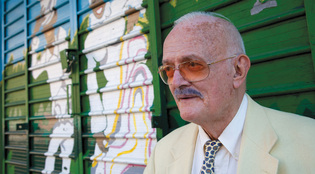 loading
loading
featuresProfessor of mamboRobert Farris Thompson—Master T—teaches "the black aesthetic of the cool."  Matthew SussmanThompson in Spanish Harlem last fall for a tribute to his work on mambo. In the background is a mural on a shuttered storefront. View full image
Imagine what you hear, art historian Robert Farris Thompson tells the students in his course on New York mambo, when you arrive from the Eighth Galaxy to inspect Planet Earth. “You hear drumming in Africa, you hear hip-hop in Chicago, you hear jazz in New Orleans, samba in Brazil, and mambo—everywhere.” Thompson ’55, ’65PhD, pitches his voice higher: “Your Highness! We have discovered life on this planet. And judging from the noise they are making, they are baaaad.” In short: you hear blackness. “Black music controls the airwaves of this planet. How did that happen? Let’s sample a little of the blackness of the airwaves.” Thompson slides a CD into the boom box: John Coltrane’sAfrica/Brass. The saxophone surges, and Thompson calls out: “Say it, Coltrane! Say it! We’re waiting for you: say it, brother!” Next comes samba, then mambo—“¡Ya! ¡Arriba!” Thompson shouts. He begins to dance along, pale and a bit stiff-jointed in his button-down shirt and tie, khaki pants, and cloth belt decorated with nautical flags. Thompson roams the lecture hall, microphone in hand. “How do black musicians manage to do this—bing! bing!—conquer the whole planet?” he asks. “It’s because black music has a few secret weapons, among them multiple meter, that is to say, several time signatures at once. It modulates from rhythm to rhythm, just as we change keys. “Multi-metric means multi-drums. Now how can you dance to that? The second great secret weapon is that different parts of the body move in different rhythms. Multiple meter demands mastery of self.” Self-mastery requires coolness, not only in the heat of the dance, but as a way of life: “The highest value is reconciliation and generosity, to be at ease, to settle quarrels. Tranquility of mind. To be cool, wet, and silent. When you hear ‘chill,’ you’re in the black aesthetic of the cool.” So begins a first day of classes, one among 45 years of first days for Thompson, the Colonel John Trumbull Professor of the History of Art and the master of Timothy Dwight College (TD) until his retirement from that post this summer. Thompson served as master for 32 years—the longest mastership in Yale history, long enough for him to have seen the daughters and sons of his former TD students pass through the college. Now 77, Thompson has spent his life exploring the art of Africa and the African diaspora. In his teaching and books, Thompson demonstrates how the traditions of the Yoruba, Kongo, Mande, Ejagham, Igbo, and other civilizations have permeated and enlivened cultural life on this side of the Atlantic, from Brazil to Cuba to New York—the place he calls “the secret African city.” Thompson’s central contribution to his field has been his insistence on understanding African art in context, understanding what it communicates on its home turf. Because of Thompson’s keen interest in context, his take on art history encompasses not only visual art and architecture, but also anthropology, language, religion, ethnomusicology, dance history, and philosophy. His aim, says one former PhD student, is to map “the artistic geography of the African world”; another says that Thompson studies “the diversity of blackness, of blacknesses.” Cornel West, who teaches African American studies at Princeton, calls this white man from Texas “my dear brother” and “one of the greatest pioneers in the study of Afro-American culture and African culture.” Thompson wants his students to recognize how aspects of African cultures infuse not only the music, art, and dance of the Americas, but also philosophy, religious practice, textile design, everyday gestures, and even vocabulary as quotidian asUh-huh (yes) and Unh-unh (no). According to David Doris ’02PhD, a professor of African art history at the University of Michigan, “He coined the term that became prevalent in academia: ‘Black Atlantic.’” Says Thompson, “We can’t know how American we are unless we know how black we are.”
|
|